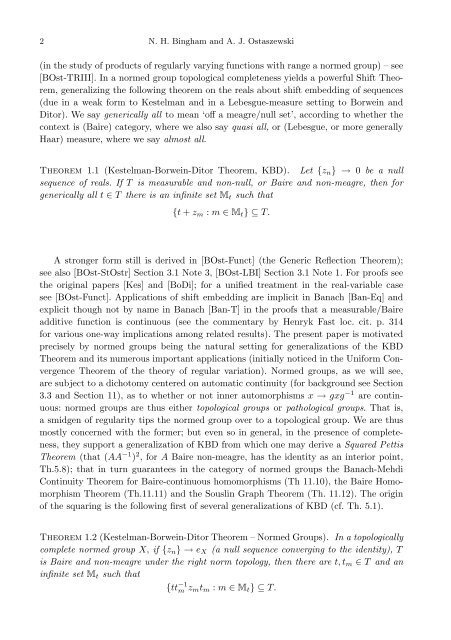Normed versus topological groups: Dichotomy and duality
Normed versus topological groups: Dichotomy and duality
Normed versus topological groups: Dichotomy and duality
Create successful ePaper yourself
Turn your PDF publications into a flip-book with our unique Google optimized e-Paper software.
2 N. H. Bingham <strong>and</strong> A. J. Ostaszewski(in the study of products of regularly varying functions with range a normed group) – see[BOst-TRIII]. In a normed group <strong>topological</strong> completeness yields a powerful Shift Theorem,generalizing the following theorem on the reals about shift embedding of sequences(due in a weak form to Kestelman <strong>and</strong> in a Lebesgue-measure setting to Borwein <strong>and</strong>Ditor). We say generically all to mean ‘off a meagre/null set’, according to whether thecontext is (Baire) category, where we also say quasi all, or (Lebesgue, or more generallyHaar) measure, where we say almost all.Theorem 1.1 (Kestelman-Borwein-Ditor Theorem, KBD). Let {z n } → 0 be a nullsequence of reals. If T is measurable <strong>and</strong> non-null, or Baire <strong>and</strong> non-meagre, then forgenerically all t ∈ T there is an infinite set M t such that{t + z m : m ∈ M t } ⊆ T.A stronger form still is derived in [BOst-Funct] (the Generic Reflection Theorem);see also [BOst-StOstr] Section 3.1 Note 3, [BOst-LBI] Section 3.1 Note 1. For proofs seethe original papers [Kes] <strong>and</strong> [BoDi]; for a unified treatment in the real-variable casesee [BOst-Funct]. Applications of shift embedding are implicit in Banach [Ban-Eq] <strong>and</strong>explicit though not by name in Banach [Ban-T] in the proofs that a measurable/Baireadditive function is continuous (see the commentary by Henryk Fast loc. cit. p. 314for various one-way implications among related results). The present paper is motivatedprecisely by normed <strong>groups</strong> being the natural setting for generalizations of the KBDTheorem <strong>and</strong> its numerous important applications (initially noticed in the Uniform ConvergenceTheorem of the theory of regular variation). <strong>Normed</strong> <strong>groups</strong>, as we will see,are subject to a dichotomy centered on automatic continuity (for background see Section3.3 <strong>and</strong> Section 11), as to whether or not inner automorphisms x → gxg −1 are continuous:normed <strong>groups</strong> are thus either <strong>topological</strong> <strong>groups</strong> or pathological <strong>groups</strong>. That is,a smidgen of regularity tips the normed group over to a <strong>topological</strong> group. We are thusmostly concerned with the former; but even so in general, in the presence of completeness,they support a generalization of KBD from which one may derive a Squared PettisTheorem (that (AA −1 ) 2 , for A Baire non-meagre, has the identity as an interior point,Th.5.8); that in turn guarantees in the category of normed <strong>groups</strong> the Banach-MehdiContinuity Theorem for Baire-continuous homomorphisms (Th 11.10), the Baire HomomorphismTheorem (Th.11.11) <strong>and</strong> the Souslin Graph Theorem (Th. 11.12). The originof the squaring is the following first of several generalizations of KBD (cf. Th. 5.1).Theorem 1.2 (Kestelman-Borwein-Ditor Theorem – <strong>Normed</strong> Groups). In a <strong>topological</strong>lycomplete normed group X, if {z n } → e X (a null sequence converging to the identity), Tis Baire <strong>and</strong> non-meagre under the right norm topology, then there are t, t m ∈ T <strong>and</strong> aninfinite set M t such that{tt −1m z m t m : m ∈ M t } ⊆ T.
















